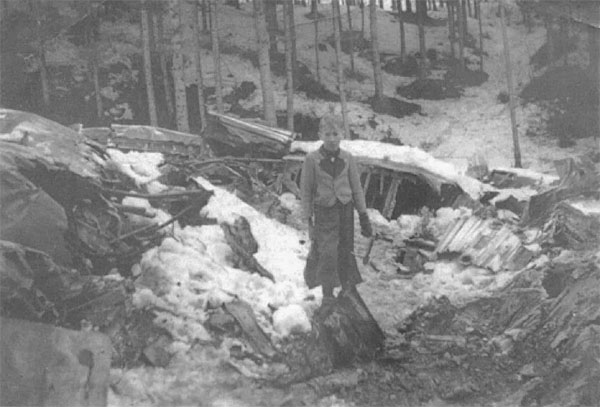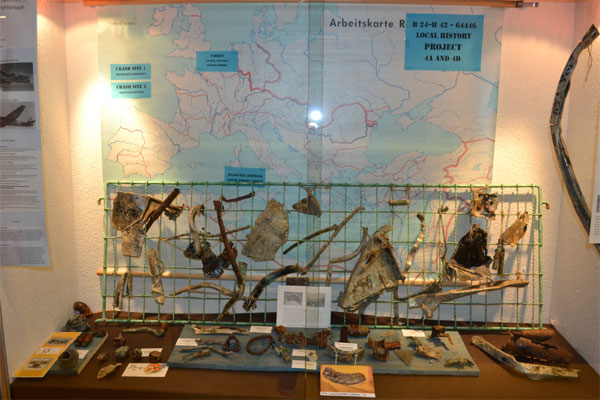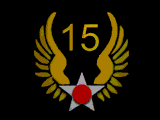|
|
Impatient Virgin
721st Squadron
|
In 2019 we completed a school project (BRG Kirchdorf high school) about the loss of Impatient Virgin (MACR 3205), collecting about 100 parts of the plane, that remained on the site, having them examined by an expert in Texas and presenting results to the public at our school. Before that I communicated with Clenton Chain´s son – his father was one of the survivors.
There were two men in the audience who had witnessed the crash when they were five and seven. The presentation took place in February 2020 shortly before our lockdown.
|

Crash Site
|

Part of the display students presented to members of the public.
|
Extract of the message from Mr Clay to Markus Steindl, who forwarded this information to our students after the students had sent him the pictures they took of the parts we found:
I had a chance to sit down with some friends who have worked on aircraft from this era. Unfortunately much of these items are a nearly impossible task to identify. Much of the riveted structural components are very repetitious throughout the structure, so they could be from any number of places. Someone undergoing a deep restoration of a B-24 might know better, even then possibly not. I can try another place to see if they can identify more of the parts. For now at least here are some of the parts we ID'd or at least gave a very good guess on. I didn't get a chance to try and dig into the exact aircraft history but I will do that as well and see if there is possibly another perspective I can give you on it; although I'm sure you have a far greater understanding of its history right now than I do!
Parts:

1)25: A portion of a cylinder head showing 2x spark plugs in it. Aircraft use dual plugs for redundancy and more thorough ignition at high altitudes.

2) 26: A possible portion of an ignition harness, for both heat protection and physical protection against damage they are often ran through hard tubes like this. Hard to say for sure though as there are any number of possibilities for small tubes on these aircraft of course.

3) 30: We are unsure of this as none of us are avionics guys, but it must be some type of coil from a radio.

4) 36: This is likely a fuel or oil tank strap, as they are often hung inside the structure in this manor, it is stainless steel and the strong ductile nature of this would be necessary in this application.

5)203: This welded tubing cluster is likely related to the oil system. The ends of the tubes have a bead rolled flare on them, you wouldn't see this type of connection on fuel lines and such. Not exactly positive on this one.

6)205: This appears to possibly be a portion of asbestos, used as an anti-chafe material in many areas on the aircraft. Due to vibration and closely moving components here and there these kinds of things are necessary. You see a lot of this type of stuff around the flaps etc where you have large moving structure etc.

7)210: Appears to be an engine pushrod still inside the shroud tube.

8)94: This is an annunciator light, you can see the multiple color lenses in it. Not specifically sure which function this particular one served as there would be many, but these are common with landing gear indicating etc. This indicator would also have a push to test feature to make sure the system is working properly and all the lights would light at once when you push it.

9)70: This is for sure an ignition harness and spark plug, being a 14 cylinder engine with 2x plugs per cylinder, you will have 28 spark plugs per engine, or 112 spark plugs on the entire aircraft! You can see the shielding on the wire harness, this is to reduce signal interference from the ignition system over the aircraft radios and communication systems. This works good but you can still hear a small ticking in your headset on smaller aircraft.

10)99: This is a “nut plate” there will be thousands of these on the aircraft, they are riveted to the aircraft structure on the inside and have the actual nut fastened on the back side to allow the blind installation of fasteners. Basically every access panel on the aircraft will be secured in this fashion.
This is a far more antiquated style of this fastener, they are quite a bit different these days, and I can tell you we change out a LOT of them haha.

11)190: Again, no positive ID on this one but it appears to be another radio coil of some sort.

12)191: This is the end portion of a cable drive. These would be used in many applications but allow the direct cable drive/transfer of a physical movement in the cockpit.

13)194: This is a so called “cannon plug” the common aircraft style electrical connection, again there will be hundreds across the entire aircraft.

14)199: This is an exhaust flange and stub portion, the intake side of the engine will use a similar tube but they will be aluminum so this rusted portion is definitely exhaust.

15) 39a: Nearly impossible to ID except it's engine related, given the steel studs in aluminum, this likely came off the back side of the engine around the accessory case or possibly part of the induction system.

16)41: Not 100% sure but this might be a break related component or possibly a mass balance of some sort, it appears to be lead filled as the metal is corroding away at different rates, the drilled holes in it, appear to indicate either a balanced rotating system, or simply lightening holes drilled again for possible usage as a mass balance. I think I am leaning toward a mass balance. Such things are necessary for smooth control function and to reduce control flutter at high speeds if that is indeed what this is.
That's about all we were sure of or fairly confident on. Here are some pictures out of a 1942 Engine manual to help illustrate some of these mentioned components. Have a good one!
Clay
|

|
MACR 3205 analysis with help from Mark COURT – information
gleaned from MACR
|
crew member
|
Serial
number
|
function
|
rank
|
status
16.3.46
|
status
|
fate after
attack
|
last contact
|
additional
information
|
information
given by
|
where were the ones who
stayed in the plane?
|
information
on plane
|
|
Harold J. Amye
MRs Odile H: Ayme
Boise, Louisiana,
wife
|
0-670683
|
Co-pilot
|
2nd Lt.
|
|
dead
|
unable to get out of the plane
ordered Carroll to leave ball turret
down?
remained in plane
door to flight deck from
bomb bay was hard to open
|
giving orders from cockpit
last seen by Lindsay
|
|
Oklahoma Carroll Jr.
X11
X12
Lindsay
|
flight deck,
cockpit
cockpit
cockpit
|
|
|
Oklahoma V. Carroll, Jr.
Eva L. Caroll Marshall
Oklahoma
mother
|
38995855
|
AR
|
Sgt.
|
RTD
|
eus
|
was in ball turret, bailed out with Ludwig
and Purcell through camera hatch, was last to get out, landed on other side
of mountain and did not see crash site or comrades (Weinzierler Brücke!)
contradiction: only saw Purcell
after the attack and bailed out with him
bailed out before Waste lost
control
|
|
Lindsay and Chain bailed out through
nose wheel door
|
Oklahoma Carroll Jr.
Purcell
|
|
engines 1 and 2 were burning, 3 and 4
were running out of control. Aileron control was shot off of left wing, plane
went into a spin
|
|
Clenton J.L. Chain
Pearl V. Chain, Bastrop,
Lousiana
mother
|
34155718
|
AG
|
Sgt.
|
|
eus
|
he bailed out with X and
was arrested with Lindsay and X went to Kiefhiede, Germany, repatriated
months later, went slightly insane
Stalag luft 4
Lindsay pulled him out of
the nose turret and opened the emergency hatch
|
last seen in Austrian
beer hall or at Frankfurt interrogation center
|
Chain bailed out through nose wheel
door
|
Oklahoma Carroll Jr.
X11
X12 in Stalag
Luft 4
Lindsay
|
|
|
|
Stanley J. Dryla
Nellie Dryla 765 Farsley
Street Swedesburg Pennsylvania
|
33186438
|
Engineer
|
S/Sgt.
|
|
dead
|
unable to get out of the plane
was hurt in turret
couldn´t release himself
reported enemy fighter at
12 o´clock
was heard talking to
pilot about turning off gasoline to burning engines by ball turret man
|
top gun turret
|
door to flight deck hard
to open
|
Oklahoma Carroll Jr.
X11
Lindsay
|
flight deck
|
|
|
Lawrence H.
Kravetz
Esther S.
Kravetz
188 Chester
Brooklyn, NY
wife
|
0-689612
|
Navigator
|
2nd Lt.
|
|
dead
KIA!
|
supposition:
did not bail out, unable to get out of
spinning plane
door to flight deck hard
to open
|
gave us position at 12:20
last seen at take off
|
we were attacked at 12:25
25 miles southwest of Steyr
|
Oklahoma Carroll Jr.
X11
Lindsay
|
flight deck
command deck
command deck
|
|
|
Bruce C. Lindsay
Margaret S. Lindsay
505 Vandover Ave
Wilmington Delaware mother
|
0-749649
|
Bombardier
|
2nd Lt.
|
RTD
|
eus
|
bailed out before Waste
lost control
|
|
|
Lindsay
Purcell
|
|
plane went into a flat
spin
|
|
Robert L. Ludwig
Mrs. Edwar d C. Ludwig
140 Clark Ave Clarks Green,
Pennsylvania
mother
|
33956052
|
Radio operator
|
S/Sgt.
|
RTD
|
eus
|
bailed out before Waste
lost control
|
German camp
Mooseburg
|
|
Ludwig
|
|
|
|
Bruce I Mahar
Margarethe Mahar 23 Maple
Street South Portland, Maine
|
31220444
|
AAG
|
Sgt.
|
|
dead
|
unable to get out of the plane
trapped in tail turret,
his gun jammed,
trapped behind camera
hatch
he was sitting on floor
trying to put his chute on – was not seen outside plane
|
talked to him on
interphone during attack
|
|
Oklahoma Carroll Jr.
X11
X12
Purcell
|
at tail gun
|
|
|
Richard A. Purcell
Mrs. Roberta P. Purcell
Irral Route Number One
Vinciennes Indiana
mother
|
35477212
|
AR
|
Sgt.
|
RTD
|
eus
|
|
|
|
|
|
|
|
Robert L. Waste
Mrs. Frances W Thegerson,
Bank Street, Tampa,
Florida mother
|
0-670683
|
Pilot
|
2nd Lt.
|
|
dead
|
unable to get out of the plane
gave order to bail out
|
gave orders to let down ball turret
last seen by
Lindsay
|
|
Oklahoma Carroll Jr.
X12 Sgt. Slg luft 4
Lindsay
|
flight deck,
trapped in cockpit
cockpit
cockpit
|
|
plane was
flying in 5 position of the high right bow, ten minutes before target hit
attacked by 13 enemy fighters Me 109, Me 110, Ju 52, in the four minutes while
making the run on the target the enemy was successful in knocking out five of
the six ships in the high box position. Sergeant Dryla´s ship was observed to
be going down at a pretty rapid rate of descent smoking profusely. Due to the
intensity of the attack, gunners in other ships were unable to observe the
destroyed ships. It must be assumed that Sgt. Dryla either was 1) injured in
enemy action in the air and parachuted out or 2) that he was injured in the air
and was killed when the plane crashed or 3) that he parachuted out and was
taken prisoner of war.
Willoughby J.
Hodge, 2nd Lt. and William H. Glavin, 2nd Lt. saw crash (722nd): in the turn to
the initial point Wels the entire squadron led by Major Miller slipped slightly
out of position and was attacked by enemy fighters, Waste´s aircraft was hit
and fire was seen coming out from the upper portion of the fuselage and the
waist window.
The plane
left formation and crashed at 47 55N 14 25 E – five declared dead 18 Oct 45
Information courtesy of Mag. Manfred G. MARTIN, History Teacher at BRG Kirchdorf an der Krems, Weinzierlerstrasse 22, A-4560 Austria
Return to Main Page
|



